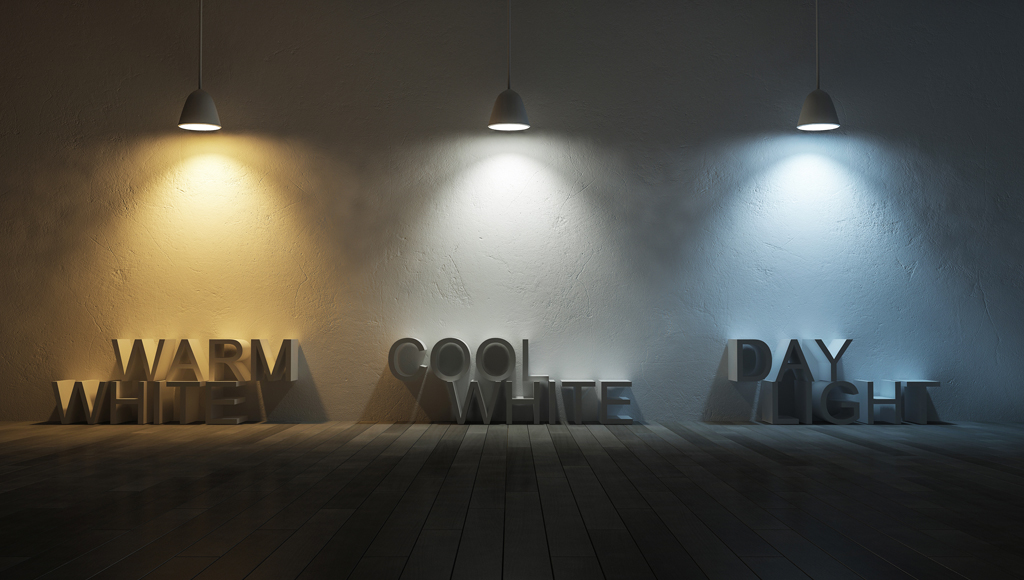Lighting Color Temperature – Which One Is Right For You March 24, 2017 – Posted in: Lighting Information, Tutorials

Table of Contents
Choosing a lighting fixture for your room is not as easy as putting whatever light bulb you have and to wherever you want to. A not so ideal lighting plan can make a room may look a little dull, a little too much or just look poorly .
One of the factors to consider in making an effective lighting plan is the color temperature, especially for interior lighting. The color of the light you are going to choose will greatly impact the overall ambiance and mood of the interior.
Understanding the effects and importance of color temperature in interior lighting can help you achieve your desired look for a certain space or room.
What Is Color Temperature?

The color temperature of a certain light source tends to have a technical definition. But we really don’t need to focus on that – the most important thing is the look and feel of the light. Basically light color corresponds to the temperature a light source emits that is based on the visible color.
It is measured using the Kelvin temperature scale. This corresponds to a range of wavelengths of the light fixture. Although the accuracy of Kelvin in certain bulbs tends to be way off, you still want to determine what you comfortable range of spectrum is going to be. You typically don’t want a really blue light source unless you’re opening a hospital. Most modern homes and businesses use cool white (4000-5500 kelvin) and more traditional homes use warm white lights (in the 2700 kelvin range).
Choosing the Color Temperature
Choosing the color temperature will depend on what mood you are trying to set and achieve. This will also be determined by the type of room, its function, and where you are going to put that new lighting fixture you just got.
There are three basic light colors to choose from:
Warm White Color Temperature

If you are going for a warm white color temperature then you should use lights with a value that ranges from 2500 to 3200 Kelvin. Lights in this range produce orange to yellow-white light in appearance.
This can create a calm, cozy, inviting, and intimate mood and feel of the whole room. Lights that have a warm white color temperature are ideal to be used in living rooms, bedrooms, kitchens, and certain bathrooms. It’s also the best choice for restaurant ambient lighting as well as for decorative outdoor lighting.
A halogen can be an excellent choice for this type of light but you can also find different types of LED light bulbs that have warmer ratings.
Cool White Color Temperature

The cool white or what is also often called as the bright white ranges from 3300 to 5500 Kelvin is called. Lights that belong in this temperature range produces a more balanced white light and can often include a slight blue tint.
Light bulbs or lamps with a cool white color temperature can create a bright and vibrant ambiance to a room. This type of light are best suited for basements, garages, and even for bathrooms – or most open areas in a contemporary home. Cool white lights also work well when used in task lighting and in work environments such as in reading areas.
This is the middle of the pack and personally my favorite style of light source.
Daylight Color Temperature
What commonly called as daylight is produced by lights and lamps which range at or above 5000 Kelvin. Daylight temperature can produce a blue-white light that is basically what a natural daytime looks like.
Light bulbs and lamps at or above 5000 Kelvin can create a crisp and invigorating mood and ambiance for a room. This type of lighting is best used for zones that need ample illumination such as in garages and display areas. This kind of light is also clear, making it ideal to be used in task lighting and security lighting.
Choosing a light at 5000 Kelvin to 5500 Kelvin can replicate the midday sunlight which is a very cool light and often creates a glare.

Matching the Color Temperature to Room Color
Color temperature can produce a very dramatic effect to a room. A clear white wall can somehow change how it appears depending on the color temperature of its light source. A certain paint color can look different when it’s under a fluorescent bulb or a light bulb. This is why it is ideal to put lighting fixtures before painting and furnishing a space or room.
The color finish of a room can also change as the day progresses and the room’s natural light decreases. It is ideal to paint color samples on different walls and checking it at various times of the day before committing to one.
There are basically no hard set rules in applying color temperature in interior lighting but there is definitely recommended temperatures for each room. This can be subjective; however, it is worth considering for its benefits and advantages when it comes to improving a room.
I have been the project manager for Modern.Place since early 2016, spending three of those years working overseas on the manufacturing & procurement side of the LED lighting industry. Constantly learning and passing on knowledge to others while excited for what the lighting industry will involve into next.


1 Comment
LED Color Temperature Chart With Real World Examples | Modern.Place June 28, 2018 - 23:16
[…] If you haven’t seen our in-depth guide on color temperature, you can see it here. […]